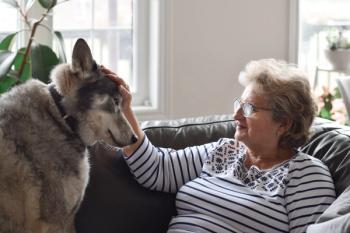
Considering patient behavior with chemotherapy
Lindsay Hallman, CVT, CCMT, VTS (Oncology) and Katelyn McDonald, CVT, VTS (Oncology), discuss methods for a calm administration and positive pet experience.
Administering chemotherapy can pose challenges for the veterinary team. In a dvm360® interview, Lindsay Hallman, CVT, CCMT, VTS (Oncology) and Katelyn McDonald, CVT, VTS (Oncology), veterinary technician specialists at Mount Laurel Animal Hospital in New Jersey, discussed how a patient’s behavior can affect the treatment process. In this video showing part of the interview, they address methods that can help ensure a calm chemotherapy administration as well as a positive patient experience.
The following is a transcript of the video, lightly edited for clarity:
dvm360: What patient behaviors should be considered when administering chemotherapy?
Lindsay Hallman, CVT, CCMT, VTS (Oncology): We work really closely with our behavior department [at Mount Laurel Animal Hospital]. We are touching base with our behavior nurses and our board-certified behaviorists on a pretty regular basis. I would say probably 75%, if not higher, of our patients do come in on some form of anti-anxiety medication. Not that all of them are not good or super wiggly— some of them are absolutely perfect angels. It's just that if they have to come in and see us every single week, we don't want them to be stressed at all.
The goal of chemotherapy and oncology in general is for quality, not quantity. That's really what our main focus is. And if they have to come in every week and they're anxious or nervous or shaking, that's not a quality experience for them. So we want everything to be really as calm and relaxed as possible.
We tend to play calming music in our room. We keep trying to [have] things a little bit on the quiet side. We're at the very end of the building, at the end of a hallway, so it generally ends up being a pretty quiet space for them.
But, behavior is something that we work really closely with [the veterinary team] to make sure that our patients are all really comfortable. We have a very large arsenal of behavior medications to use, thanks to our boarded behaviorist. So if something's not working, we're always shifting things around and playing with different medications, but we try and keep them as calm and as happy as possible.
Katelyn McDonald, CVT, VTS (Oncology): Sometimes it can be challenging for owners to hear that they can't be with their pets during chemotherapy. Very often, owners have the conception that the pets are going to behave better with them. They're going to be calmer with them, which may in fact, be true, but from a safety standpoint, we cannot have owners with us while we're administering chemotherapy to their pets.
In addition to having the behavior medications and consulting with our behavior team, like Lindsay said, we have an arsenal of different goodies and treats and things to promote a positive experience when they come in. So we are the cookie monsters.
When they come in, we very often have patients that are very apprehensive, nervous at the beginning of their treatment. But as time goes on, we establish relationships with these patients. They get to know us. They get excited to see us walk out into the waiting room and come back. We're able to be there with things like lick mats slathered in peanut butter that they will actually consume while they are receiving their treatment. So they get to go to their happy place simultaneously while we are administering chemotherapy. It's honestly a very different experience than I think what a lot of people have in their heads.
Newsletter
From exam room tips to practice management insights, get trusted veterinary news delivered straight to your inbox—subscribe to dvm360.






